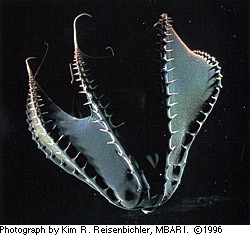The bathyal zone or bathypelagic (also known as midnight zone) is the part of
the pelagic zone that extends from a depth of 1000 to 4000
metres (3300 to 13000 feet) below the ocean surface. It lies
between the mesopelagic above, and the abyssopelagic below. The average temperature hovers at
about 4 °C (39 °F).
Animals of the
Bathypelagic Zone
·
rely on detritus for
food or on eating other animals in this zone.
·
not threatened by predators that can see them,
·
do not have powerful muscles.
·
need to have the right adaptations to survive in this lethal
area.
At this
depth and pressure, the animals most commonly found are fish, mollusks,
crustaceans, and jellyfish.
In the
bathyal some of the world's largest whales feed. Sperm whales will hunt at these depths on occasion to prey on
giant squid.
Black and red are the predominant colours of
animals here and any bioluminescence is usually blue since red is not visible
at these depths. The most common mollusk in the bathypelagic zone is the vampire squid, an animal that can turn itself inside-out to
use its spiky tentacles to deter predators or capture prey. Many
forms of nekton live in the bathyal zone, such as squid, large whales, and octopuses.
Sponges, brachiopods, sea stars, and echinoids are also common in the bathyal
zone.
Due to
the lack of light
- Sunlight does not reach this zone( no primary production) and difficult for fish to survive.
- some species do not have eyes, however those possessing eyes in this zone include the viperfish and the frill shark.
The fish
in this zone:
- · energy efficient( hard to find nutrients)
- · slow metabolic rates to conserve energy
- · weak muscles
- · soft skin
- · slimy bodies
- · small eyes
- · transparent skin
Picture above:The tentacles are often thrown
over prey like a net from above.
The
snake dragonfish resembles the viperfish or dragonfish of the mesopelagic zone
and also comes up to hunt at night but has to travel further as it lives in
deeper water than the others.
 The anglerfish of the bathypelagic zone is
well known for its enormous mouth and a lure that resembles a flashlight on its
head. Not only does the angler fish have huge long teeth on the jaws, it is
also equipped with teeth in its throat! Males of this species are found in the
form of a tiny parasitic fish carried by the female near her genitals. Both
sexes can be found anywhere from the surface to the deepest waters.
The anglerfish of the bathypelagic zone is
well known for its enormous mouth and a lure that resembles a flashlight on its
head. Not only does the angler fish have huge long teeth on the jaws, it is
also equipped with teeth in its throat! Males of this species are found in the
form of a tiny parasitic fish carried by the female near her genitals. Both
sexes can be found anywhere from the surface to the deepest waters.
Amphipods are crustaceans and scavengers in
the bathypelagic zone that hide using a transparent red body. Other crustaceans
found in the bathypelagic zone include shrimp.
Echinoderms seem to do well in deep ocean
water, although they are not usually found in the open ocean. They survive by
scouting out detritus on the ocean floor or by swimming through the water
hunting for floating food.
Slime stars are in the echinoderm family and
can reach up to 21 cm in length—large for an echinoderm.





No comments:
Post a Comment